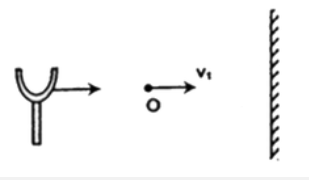A turning fork vibrating at 500Hz falls from rest accelerates at 10m/s2.
Velocity of the tuning fork when waves with a frequency of 475Hz reach the release point is ( Take the speed of sound in air to be 340m/s).
1.79m/s
17.9m/s
35.8m/s
3.58m/s
The correct Answer is:B
To solve the problem step by step, we will use the formula for the apparent frequency in the Doppler effect:
Step 1: Understand the given information
- Frequency of the tuning fork (f) = 500 Hz
- Apparent frequency (f') = 475 Hz
- Speed of sound in air (v) = 340 m/s
- Initial velocity of the observer (vo) = 0 m/s (since the observer is at the release point)
- The tuning fork is falling with an acceleration of 10 m/s².
Step 2: Use the Doppler effect formula
The formula for the apparent frequency when the source is moving away from the observer is given by:
f′=fv+vov−vs
Where:
- f′ = apparent frequency
- f = actual frequency of the source
- v = speed of sound
- vo = velocity of the observer
- vs = velocity of the source (tuning fork)
Step 3: Substitute known values into the formula
Substituting the known values into the equation:
475=500340+0340−vs
Step 4: Simplify the equation
This simplifies to:
475=500340340−vs
Step 5: Cross-multiply to eliminate the fraction
Cross-multiplying gives:
475(340−vs)=500×340
Step 6: Expand and rearrange the equation
Expanding the left side:
161500−475vs=170000
Now, rearranging to solve for vs:
−475vs=170000−161500
−475vs=8500
Step 7: Solve for vs
Dividing both sides by -475:
vs=8500475≈17.89 m/s
Conclusion
The velocity of the tuning fork when the waves with a frequency of 475 Hz reach the release point is approximately 17.89 m/s.
- Frequency of the tuning fork (f) = 500 Hz
- Apparent frequency (f') = 475 Hz
- Speed of sound in air (v) = 340 m/s
- Initial velocity of the observer (vo) = 0 m/s (since the observer is at the release point)
- The tuning fork is falling with an acceleration of 10 m/s².
The formula for the apparent frequency when the source is moving away from the observer is given by:
- f′ = apparent frequency
- f = actual frequency of the source
- v = speed of sound
- vo = velocity of the observer
- vs = velocity of the source (tuning fork)
Substituting the known values into the equation:
This simplifies to:
Cross-multiplying gives:
Expanding the left side:
Dividing both sides by -475:
The velocity of the tuning fork when the waves with a frequency of 475 Hz reach the release point is approximately 17.89 m/s.
Topper's Solved these Questions
- SUPERPOSITION AND STANDING WAVESBook:CENGAGE PHYSICS ENGLISHChapter:SUPERPOSITION AND STANDING WAVESExercise:Integer
Explore 9 Videos
- SUPERPOSITION AND STANDING WAVESBook:CENGAGE PHYSICS ENGLISHChapter:SUPERPOSITION AND STANDING WAVESExercise:Single Correct Answer Type
Explore 56 Videos
- SUPERPOSITION AND STANDING WAVESBook:CENGAGE PHYSICS ENGLISHChapter:SUPERPOSITION AND STANDING WAVESExercise:Assertion - Reasoning
Explore 6 Videos
- SOUND WAVES AND DOPPLER EFFECTBook:CENGAGE PHYSICS ENGLISHChapter:SOUND WAVES AND DOPPLER EFFECTExercise:Integer
Explore 16 Videos
- THERMODYNAMICSBook:CENGAGE PHYSICS ENGLISHChapter:THERMODYNAMICSExercise:24
Explore 1 Video
Similar Questions
A turning fork vibrating at 500Hz falls from rest accelerates at 10m/s2.
How far below the point of release is the tuning fork when wave with a frequency of 475Hz reach the release point ?
View SolutionA turning fork vibrating at 500Hz falls from rest accelerates at 10m/s2.
Time taken by the waves with a frequency of 475Hz to reach the release point is nearly
View SolutionA closed organ pipe can vibrate at a minimum frequency of 500 Hz. Find the length of the tube. Speed of sound in air =340ms−1.
View SolutionHow far does the sound travel in air when a tuning fork of frequency 500 Hz completes 25 vibrations ? Velocity of sound in air is 332 ms−1.
View SolutionDistance travelled by the sound produced by a tuning fork of frequency 50 Hz completing 200 vibrations is, (the velocity of sound in air is 330 m/s)
View SolutionTwo tuning forks A and B lying on opposite sides of observer 'O' and of natural frequency 80Hz move with velocity 10m/s relative to stationary observer O. Fork A moves away from the observer while the fork B moves towards him. A wind with a speed 10m/s is blowing in the direction of motion of fork A. Find the beat frequency measured by the observer in Hz. [Take speed of sound in air as 340m/s].
View SolutionA railroad train is travelling at 30.0 m/s in still air. The frequency of the note emitted by the train whistle is 262 Hz. Speed of sound in air is 340 m/s.
View SolutionAn open pipe of length 2m is dipped in water . To what depth x is to be immersed in water so that it may resonate with a tuning fork of frequency 170Hz when vibrating in its overtone . Speed of sound in air is 340m/s
View SolutionIn a resonance tube experiment, a closed organ pipe of diameter 10 cm and of length 120 cm resonates, when tuned with a tuning fork of frequency 340 Hz. If water is poured into the pipe, then (speed of sound in air 340ms−1).
View SolutionThere is a source of sound (a tuning fork) moving towards a reflecting wall will a speed of 30ms−1. The velocity of the sound in air is 330ms−1and the frequency of the tuning fork is 600 Hz. The observer is between the source and the wall and is moving with some velocity V1 towards the wall. The beat frequency heard by the observer is 4 Hz. If the tuning fork is waxed, the frequency beats heard by the observer becomes 3 Hz. If the new frequency of tuning fork is k then k/50 is

View Solution
